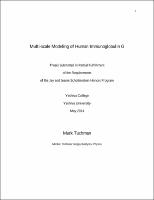Please use this identifier to cite or link to this item:
https://hdl.handle.net/20.500.12202/4156Full metadata record
| DC Field | Value | Language |
|---|---|---|
| dc.contributor.author | Tuchman, Mark | |
| dc.date.accessioned | 2018-11-08T20:08:19Z | |
| dc.date.available | 2018-11-08T20:08:19Z | |
| dc.date.issued | 2014-05 | |
| dc.identifier.uri | https://hdl.handle.net/20.500.12202/4156 | |
| dc.identifier.uri | https://ezproxy.yu.edu/login?url=https://repository.yu.edu/handle/20.500.12202/4156 | |
| dc.description | The file is restricted for YU community access only. | |
| dc.description.abstract | Immunoglobulin G is a Y-shaped globular protein, made up of four protein chains folded together into three major sections. A color model of the molecule can be seen in Figure 1. Both the role and structure of IgG make it a prime candidate for computational analysis. As an important antibody for fighting infection of body tissue, IgG has many biochemical properties that would be ideally replicated in the development of advanced pharmaceuticals. A proper understanding of how the molecule behaves in various contexts can help us better simulate its infection fighting ability through artificial means. With a proper analysis of the molecule, medical and pharmaceutical companies would be better equipped to model such behavior in the future. | en_US |
| dc.description.sponsorship | Jay and Jeanie Schottenstein Honors Program | en_US |
| dc.language.iso | en_US | en_US |
| dc.publisher | Yeshiva College | en_US |
| dc.rights | Attribution-NonCommercial-NoDerivs 3.0 United States | * |
| dc.rights.uri | http://creativecommons.org/licenses/by-nc-nd/3.0/us/ | * |
| dc.subject | Immunoglobulin G. | en_US |
| dc.title | Multi-scale Modeling of Human Immunoglobulin G | en_US |
| dc.type | Thesis | en_US |
| Appears in Collections: | Jay and Jeanie Schottenstein Honors Student Theses | |
Files in This Item:
| File | Description | Size | Format | |
|---|---|---|---|---|
| Mark-Tuchman.pdf Restricted Access | 521.52 kB | Adobe PDF |  View/Open |
This item is licensed under a Creative Commons License

